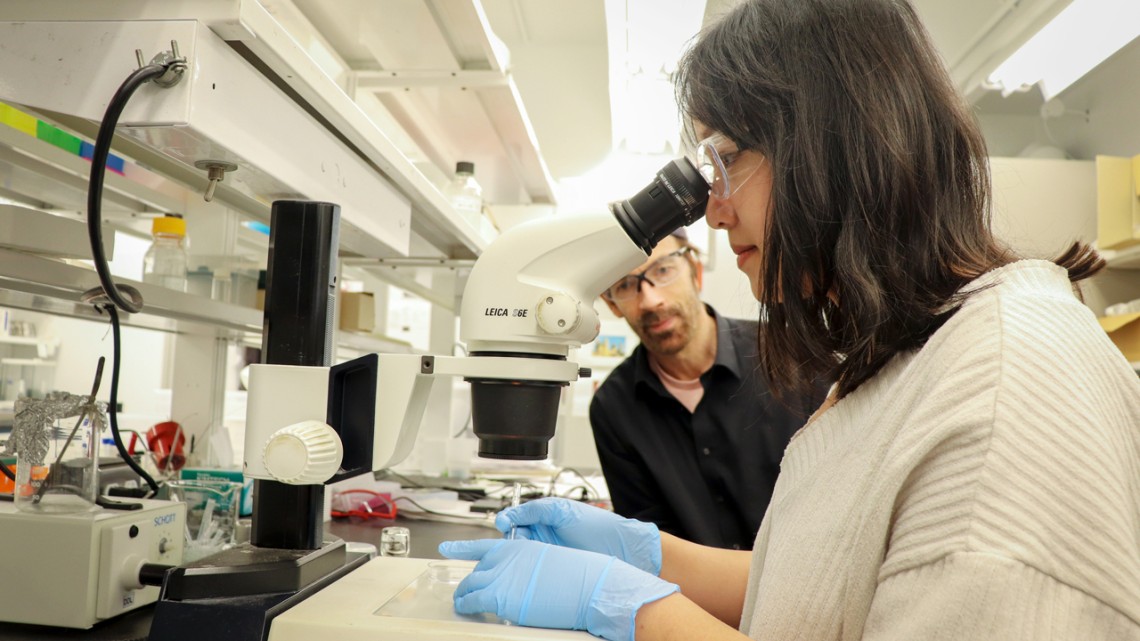
Boyce Thompson Institute faculty member Frank Schroeder, back, and graduate student Jingfang Yu work in BTI’s Center for Advanced Mass Spectrometry.
New serotonin findings could help treat depression, anxiety
By Aaron J. Bouchie
New research from the Boyce Thompson Institute on the neurotransmitter serotonin, which carries messages between nerve cells and is thought to play a role in several mental health conditions, could ultimately lead to new therapeutics for anxiety and depression.
Frank Schroeder, BTI faculty member, is co-senior author of “Parallel Pathways for Serotonin Biosynthesis and Metabolism in C. elegans,” which published Oct. 10 in Nature Chemical Biology. The first author is Jingfang Yu, a graduate student in Schroeder’s lab.
Discovered in the 1930s, serotonin is produced in many animals and mediates behaviors such as feeding, sleep, mood and cognition. Drugs that alter serotonin levels are the main weapon for treating psychological conditions such as anxiety, depression and eating disorders.
As a simple model for neurobiology research, the microscopic roundworm Caenorhabditis elegans has been used extensively to study serotonin’s role in regulating behavior and food intake. For many years, researchers thought that serotonin was made in C. elegans by one specific molecular pathway, and that serotonin was then quickly degraded.
But research by Schroeder’s team and colleagues at Columbia University refuted those assumptions.
“We discovered a second, parallel biosynthetic pathway that accounts for about half of the total serotonin produced in our model system,” said Schroeder, a professor of chemistry and chemical biology in the College of Arts and Sciences.
The work began about three years ago, when the researchers unexpectedly discovered an enzyme that converts serotonin into derivative compounds.
“Most people in the field thought serotonin is made and then quickly broken down,” Schroeder said, “but we found that, instead, it is used as a building block for other compounds that are responsible for some of serotonin’s activity. So we decided to start at the beginning and see how serotonin is made, and then how it is converted into these new molecules.”
Yu further showed that the new serotonin derivatives affect feeding behavior.
“When the worms lack endogenous serotonin, they tend to move quickly across the bacteria ‘food lawn’ [in a petri dish] and turn infrequently to explore the food,” Yu said. “We found this behavior can be alleviated by treating the worms with serotonin derivatives, suggesting these newly identified compounds contribute to effects previously attributed to serotonin.”
C. elegans is an excellent model for studying serotonin because the compound’s molecular signaling pathways are very similar across species, including humans. For example, the researchers showed that in C. elegans, a large portion of serotonin is made in the gut, which is also the case in humans.
Schroeder said there are hints that human serotonin is converted into metabolites similar to the ones identified in C. elegans, which opens up many more avenues of research.
“Are the analogous metabolites important in humans?” he said. “What is the role of one manufacturing pathway versus the other? How are these manufacturing pathways and metabolites important for human behaviors?”
Aaron J. Bouchie is a science writer at Boyce Thompson Institute.
Media Contact
Get Cornell news delivered right to your inbox.
Subscribe
